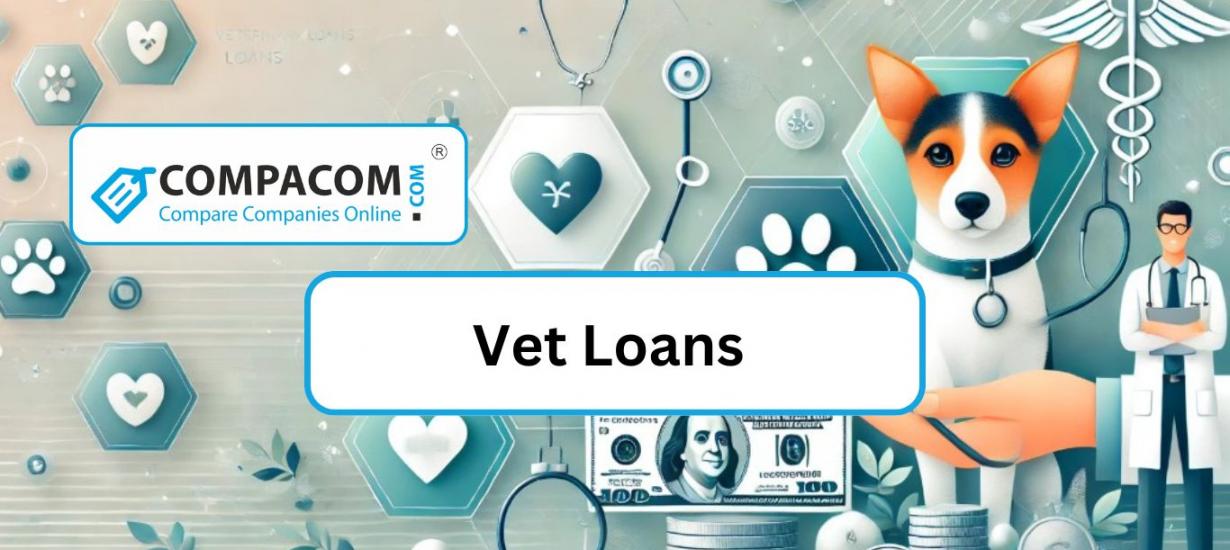No one ever plans for emergencies with their beloved pets. But life, with its twists and turns, sometimes throws us curveballs: a dog breaks a leg, a cat swallows something it shouldn't, or your bird starts having trouble breathing. When these moments happen, the vet bills can feel overwhelming. Suddenly, you're staring at a $1,500, $3,000, or even higher bill, wondering how you'll manage to pay when your wallet is empty.
This shouldn't be a roadblock, not when it comes to your pet's health. That’s why we offer a solution – veterinary loans that can help you cover these unexpected expenses and get your pet back to feeling their best. After all, choosing between your pet’s well-being and your budget should never be a decision you have to make.
Ad
What Are Veterinary Loans and How Do They Help?
Your pet isn’t “just” an animal. They’re family – greeting you at the door after a long day, sharing in your joys, and comforting you in tough times. When they’re unwell, it cuts deep. And while you’d do anything to make them better, those sky-high vet bills can knock you off balance.
Veterinary loans are here to help when you can’t let your furry family member go without care. They cover everything: emergency surgeries, diagnostics, vaccinations, and even routine checkups. With loans ranging from $500 to $10,000, you can get the funds you need to start treatment immediately. It’s all straightforward and transparent – you’ll always know exactly how much you’re borrowing and repaying. Because when it comes to the unconditional love of your pet, money should never stand in the way.
How much would you like to get?
-
Easy online application
-
Bad credit is OK
-
Instant approval
-
No credit check considered
-
Competitive rates
-
Same day financing
-
Quick Cash with Mobile Apps
Why People Choose Us?
We understand how hard it can be to find the funds to care for your pet, especially when the bills catch you off guard. That’s why our loans are designed with your needs in mind. Here's why so many trust us:
- Fast Approval
When your four-legged friend is in trouble, every minute counts. Our process is so quick and easy that you can get approved in just 5 minutes, with the money in your account within 24 hours. No more waiting for banks or lenders to decide if you’re worth the risk.
- Open to All Credit Scores
Bad credit? No problem. We believe that past mistakes shouldn’t cost your pet their health. With our loans, you can borrow up to $5,000, even if you’ve had financial hiccups.
- Flexible Terms
Every situation is unique, which is why we offer repayment terms up to 24 months. You can choose a plan that fits your budget, with small payments that won’t leave you stretched too thin.
- Honest and Transparent
No hidden fees. No surprise charges. You’ll know exactly how much you’re borrowing and what it’ll take to pay it back. That peace of mind means you can focus on what truly matters – your pet’s recovery.
We’ve been there – on the edge, unsure how to cover the costs. That’s why we’ve made the process as seamless as possible. Let us help you when you and your pet need it most.
Ad
What Can a Veterinary Loan Cover?
Vet expenses come in all shapes and sizes, and every situation calls for a tailored solution. Our loans cover nearly every aspect of your pet’s health, from urgent medical care to routine wellness needs. Here’s how you can use the funds to keep your furry companion healthy and happy:
- Surgeries and Critical Treatments
When it comes to surgeries, bills can skyrocket to $2,000, $5,000, or even more. Broken bones, tumor removals, spaying, or recovery from injuries are essential but costly. With our loans, you can secure the necessary funds quickly, ensuring your four-legged family member gets the professional care they need without delay.
- Emergency Situations
Sometimes, trouble strikes out of nowhere. Poisonings, accidents, or sudden illnesses demand immediate attention. Hospital stays and urgent diagnostics can easily cost $1,500-$4,000. Our loans help you handle these unexpected expenses so your loyal companion gets the care they need right away.
- Chronic Condition Management
Some health issues require ongoing treatment. Conditions like diabetes, heart disease, or joint problems in cats and dogs can cost anywhere from $3,000 to $6,000 annually. We provide financial support so you can continue caring for your furry friend without stressing over constant expenses.
- Routine Care: Vaccinations and Checkups
Regular vaccinations, preventive checkups, and basic procedures typically range from $100 to $500. While these costs might seem small, frequent visits can strain your budget over time. Our loans make it easier to cover these routine expenses, keeping your pet healthy year-round.
- Dental Care
Dental health isn’t just important for people – it’s vital for pets too. Teeth cleaning, tartar removal, or cavity treatments can cost $500-$1,200. Ignoring these issues can lead to infections and serious complications. With our loans, you can ensure your pet gets quality dental care before problems escalate.
No matter what your pet needs, we’re here to help. Whether they’re furry, feathered, or fluffy, your beloved companion deserves the best care. Our loans make that possible.
How to Apply for a Veterinary Loan?
We get it – when you’re in a stressful situation, you need to act fast and without unnecessary hurdles. That’s why we’ve made the loan application process as simple as possible. Here’s how it works:
Step 1: Choose Your Amount and Term
On our website, you can immediately select the amount you need – anywhere from $500 to $10,000. This way, you’re borrowing just enough to cover your specific expenses, whether it’s a surgery or a routine checkup. You’ll also have the flexibility to choose a repayment term that suits your budget, ranging from a few months to 24 months. For example, a $1,500 loan can be stretched over 12 months, making the monthly payments more manageable. Everything is designed with your convenience in mind.
Step 2: Fill Out the Application
Our application form is so straightforward that it won’t take you more than five minutes to complete. You’ll just need to provide the basics: the loan amount, repayment term, your contact information, and details for the fund transfer. No complex paperwork, job verification, or income checks are required. Even if you already have loans or other financial obligations, you can still apply. The key is being ready to help your furry friend in time.
Step 3: Get Approved
Once you submit your application, our system will review it automatically and provide an answer within five minutes. That means you’ll quickly know if you can cover your veterinary expenses. We’ve eliminated the delays often associated with banks. Approval is instant, so you can move to the next step in just a few minutes.
Step 4: Receive Your Funds
As soon as your application is approved, the funds will be sent to your account. In most cases, the money will arrive within 24 hours, enabling you to pay for treatments, surgeries, or diagnostics on time. For example, if you apply in the morning, you could have the funds ready to settle the clinic bill the very next day. You’ll always know exactly when the transfer will happen, so you can plan without added stress.
This process is designed to get you the support you need as quickly as possible. Taking care of your furry, feathered, or even scaly family member shouldn’t have to wait!
Ad
What to Do If You Have Bad Credit?
Life isn’t always smooth sailing, and financial struggles happen to the best of us. We get it – past mistakes shouldn’t stand in the way of caring for your furry companion. If your credit score isn’t where you’d like it to be, that doesn’t mean you’re out of options for getting the help you need.
Our loans are accessible even if you have bad credit. This is possible thanks to our no credit check system, which doesn’t judge your eligibility based on old missed payments or defaults. Instead, we focus on your current financial situation: your income, ability to make regular payments, and other factors that provide a fair and realistic view of your financial health.
For instance, if you’ve recently faced challenges but have a stable source of income, you can still qualify. Loan amounts for customers with poor credit range from $500 to $5,000, which is usually enough to cover most veterinary costs, including surgeries, emergency treatments, or ongoing care.
Many people worry that a low credit score automatically means rejection. But we’ve designed our process to be as inclusive as possible: no complicated credit checks, minimal paperwork, and fast approval. Our goal is to provide support, not judgment.
Your pet deserves the best care, no matter what your credit history looks like. Let us help you take care of them!
What If This Option Isn’t Right for You?
We understand that every situation is unique, and sometimes it’s worth exploring other ways to fund your pet’s care. Here are a few alternatives that might help you handle those vet bills:
- Pet Insurance
Pet insurance is a long-term solution for managing medical expenses. Policies often cover 70-90% of costs, including surgeries, diagnostics, and treatment for chronic conditions. However, keep in mind that insurance doesn’t cover pre-existing conditions or emergencies that happen before your policy takes effect. For instance, a policy costing $25-$50 per month might reimburse up to $10,000 for major treatments, but the sign-up and activation process can take time.
- Credit Cards
Credit cards work well for smaller or urgent expenses like vaccinations, tests, or routine checkups. For example, a $500-$1,000 vet bill can be covered quickly if your card’s credit limit allows. However, standard interest rates of 20-25% APR on unpaid balances can turn manageable bills into a heavy financial burden if not paid off promptly.
- Pet Loans
Specialized loans for pet expenses offer flexible amounts, typically ranging from $500 to $10,000. These loans often come with lower interest rates than credit cards and feature fixed monthly payments. For instance, a $2,000 loan over 12 months might require monthly payments of about $180, making it a practical option for larger expenses.
- Vet Payment Plans
Some veterinary clinics allow you to pay bills in installments. For example, a $3,000 surgery could be split into monthly payments of $250 over a year. However, many plans require an upfront deposit, often up to 50% of the bill, and not all clinics provide this option.
- Service Animal Grants
If your pet is a service animal, such as a guide dog, you might qualify for grants. These programs, typically offered by charitable organizations, can cover up to $1,000 in expenses. However, they usually require an application, proof of your pet’s status, and verification of your income, with the approval process potentially taking several weeks.
- Our Other Loans
We offer a wide variety of loans tailored for any veterinary need: payday, installment, personal, title, tribal, and allotment loans. Each option is designed for flexibility and speed, so you can get your pet the care they need without delay.
Whatever your situation, there’s a solution to ensure your beloved companion gets the care they deserve.
What Other Loans Can You Get from Us?
If you need funding for other purposes, our emergency loans offer flexibility and a variety of options to suit your needs. Here are the main types of loans we provide, along with their features:
Short-term loans of up to $1,000 designed to cover urgent expenses until your next paycheck. These are ideal for small amounts, such as covering a vet consultation or diagnostic tests. Repayment is usually a one-time payment, with terms ranging from 2-4 weeks.
With installment loans, you can borrow up to $5,000 with fixed monthly payments. For example, a $2,000 loan can be repaid over 12 months at around $180 per month. This option is perfect for larger veterinary bills that can’t be covered all at once.
Flexible loans of up to $10,000 that can be used for any purpose, including long-term treatments or surgeries. Repayment terms range from a few months to 2 years, with fixed payments that make budgeting predictable.
If you need a larger sum, loans secured by your vehicle can provide up to $25,000. They’re ideal for covering major surgeries or extended hospital stays. You keep driving your car while repaying the loan, so your transportation isn’t affected.
These loans are accessible even to customers with poor credit. Amounts of up to $2,500 are available for short-term needs, with flexible repayment terms. This option is a quick way to secure funds when other financing methods aren’t available.
Loans of up to $5,000 tailored for federal employees with steady incomes. These loans offer reliable terms and are available even to those who already have existing financial obligations.
Whatever your needs, we have a loan option to help you navigate life’s challenges with confidence.
Let’s Care for Your Pet Together
Don’t wait to provide the help your loyal companion deserves. Apply now and get the funds you need as early as tomorrow. We’re here to support you and your beloved pet every step of the way.
If you need more information or assistance with your application, reach out to our support team. We’re happy to answer your questions and make the process as smooth as possible.
Your pet deserves the very best, and we’re here to help you make that happen!











You are about to post a question on compacom.com:
Any comments or reviews made on this website are only individual opinions of the readers and followers of the website. The website and its authors team are not responsible, nor will be held liable, for anything anyone says or writes in the comments. Further, the author is not liable for its’ readers’ statements nor the laws which they may break in the USA or their state through their comments’ content, implication, and intent.